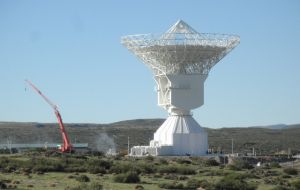MercoPress. South Atlantic News Agency
Europe opens state of the art satellite tracking station in Argentina
 The moving antenna at the Malargue station weighs 600 tons
The moving antenna at the Malargue station weighs 600 tons A new satellite tracking station at Malargue, Mendoza, Argentina, was formally inaugurated on Tuesday, completing the trio of deep-space stations and confirming ESA, European Space Agency, as one of the world's most technologically advanced space organisations.
The massive radio reflector dish of ESA's new station (DS3) is the most visible indication of the impressive technology that will track missions voyaging hundreds of millions of kilometres deep in our Solar System.
Forty metres tall and with a moving antenna assembly weighing 610 tonnes, the station strikes a starkly beautiful pose 1500 meters up on an arid Argentine plain, where high tech meets the high Pampas.
In addition to tracking missions at Mars and Venus, it can also conduct radio science experiments, allowing scientists in Europe and Argentina to study the matter through which the spacecraft-ground communication signals travel.
In exchange for hosting it for a planned 50 years, the station's capacity will be shared with Argentina whose CONAE national space office was an instrumental partner. The overall investment was estimated in 60 million dollars.
“Malargue station receives X- and Ka-band radio signals, significantly boosting its ability to receive large amounts of data from very far away,” says ESA's Roberto Madde, station project manager.
“It's a marvellous piece of engineering, and years of design and development work at the Agency have come to fruition.
“We were helped a lot by our Argentine partners in the making of the station and this collaboration shows how good the relationship between ESA and CONAE is.”
A 20 kW amplifier enables transmission of tele-commands hundreds of millions of kilometres into space, while low-noise amplifiers cooled to -258 degrees C enable receipt of ultra-weak signals from beyond Jupiter.
Construction began in January 2010, and the station was substantially complete by spring 2012. The first test signals from Mars Express, orbiting the Red Planet 193 million km from Earth, were received on 14 June 2012.
Joining DSA 1 in New Norcia, Australia, and DSA 2 in Cebreros, Spain, DSA 3 Malarguee provides the final leg in ESA's global coverage for deep-space probes, which typically operate well beyond two million km from Earth and where communications require highly accurate pointing.
“With the Malargue station, ESA becomes only the second space agency in the world to provide all-sky coverage for deep-space missions,” said Jean-Jacques Dordain, ESA's Director General. He added “this is a tremendous asset not only for Europe but also for all our international partners in the exploration of the Solar System.”




Top Comments
Disclaimer & comment rules-

-

-

Read all commentsGood, we should be able to keep a close eye on them here and right under their nose. Obviously the story of the Trojan horse never got taught in Argentine history, too full of bogus claims to fictitious lands and people who never existed.
Dec 19th, 2012 - 07:51 am 0apparently it's and IMF debt tracking station, it's in the right place jajajajaja
Dec 19th, 2012 - 08:30 am 0You think they think this is a new weapons platform like the academic radio array, that had hector 'american citizen' strawman so rattled in the falklands?
Dec 19th, 2012 - 08:56 am 0Commenting for this story is now closed.
If you have a Facebook account, become a fan and comment on our Facebook Page!